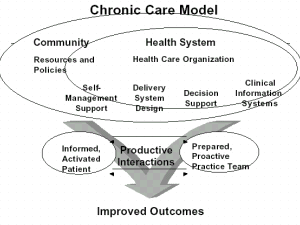 
|
|
![]()

How
to Make Systems Changes
|
| Guideline
Development Process |
| 1.
Put together your guideline development team: - Clinical champion - Administrative leader - Day-to-day leader - Technical expert |
| 2. Compile published guidelines. |
| 3.
Supplement with recent reviews: Written after or not included in the published guidelines. |
| 4. Conduct a focused literature review. |
| 5.
Customize the guideline for your facility to promote ownership. |
|
6. Develop tools/mechanisms to assist implementation: Standing orders, reminder systems, system changes. |
| 7.
Educate Providers: Academic detailing. |
| 8.
Monitor implementation and adherence: PDSA cycles (see Model for Improvement). |
| 9.
Fine tune guideline continuously: Update from the Medical literature. Modify on the basis local use. |
| 10.
Conduct regular review of guideline: Work of the guideline committee just begins with the distribution of the guideline. |
| Note |
| In order to achieve acceptance and use of a guideline it is often necessary to develop local clinical practice recommendations. |
Productive
Interactions.
The elements of good chronic illness care require productive clinical
interactions between informed activated patients and prepared proactive
practice teams. An informed activated patient understands the disease
process, and realizes his/her role as the daily self-manager. The
proactive team members have the patient information, decision support,
people, equipment, and time required to deliver evidence-based clinical
management and self-management support at the time of the visit.
A thorough assessment is conducted and clinical management is guided
by tailoring clinical management protocols to the needs and preferences
of the patient. As a result of their interaction a shared care plan
is developed including goal setting and problem solving. Active,
sustained followed up ensures progress toward meeting the goals
and amending management to meet them.
| Note |
| The elements of good chronic illness care require productive clinical interactions between informed activated patients and prepared proactive practice teams. |
Support from the health system and the community is necessary to facilitate the productive interaction between patients and providers. The key elements required from them include:
- Health
Care Organization
- Goals for chronic illnesses are a measurable part of the organization's annual business plan.
- Benefits that health plans provide are designed to promote good chronic illness care.
- Provider incentives are designed to improve chronic illness care.
- Improvement strategies that are known to be effective are used to achieve comprehensive system change.
-
Senior leaders visibly support improvement in chronic illness
care.
- Community
Resources and Policies
- Effective programs are identified and patients are encouraged to participate.
- Partnerships with community organizations are formed to develop evidence-based programs and health policies that support chronic care.
- Health plans coordinate chronic illness guidelines, measures and care resources throughout the community.
Specific elements within health care organizations for proper chronic illness care include:
-
Self-management Support
- Providers emphasize the patient's active and central role in managing their illness.
- Standardized patient assessments include self-management knowledge, skills, confidence, supports, and barriers.
- Effective behavior change interventions and ongoing support with peers or professionals are provided.
-
Collaborative care planning and assistance with problem solving
are assured by the care team.
- Decision
Support
- Evidence based guidelines are embedded into daily clinical practice.
- Specialist expertise is integrated into primary care.
- Provider education modalities proven to change practice behavior are utilized.
-
Patients are informed of guidelines pertinent to their care.
- Delivery
System Design
- Team roles are defined and tasks delegated.
- Planned visits are used to provide care.
- Continuity is assured by the primary care team.
-
Regular follow-up is ensured.
- Clinical
Information Systems
- There is a registry with clinically useful and timely information.
- Care reminders and feedback for providers and patients are built into the information system.
- Relevant patient subgroups can be identified for proactive care.
-
Individual patient care planning is facilitated by the information
system.
-Return
to the Top-
-Return Home-
Introduction Overview & Background :: Needs: Priorities for Systems Change :: Framework: Assess Needs & Goals
How to Make System Changes :: What We Want to Achieve :: Issues: Obstacles to Overcome
Evaluation: Measuring Change :: Toolbox: Links & Resources
Search this Site :: Site Map :: Frequently Asked Questions :: Privacy Statement
 A
complete description of the
A
complete description of the



